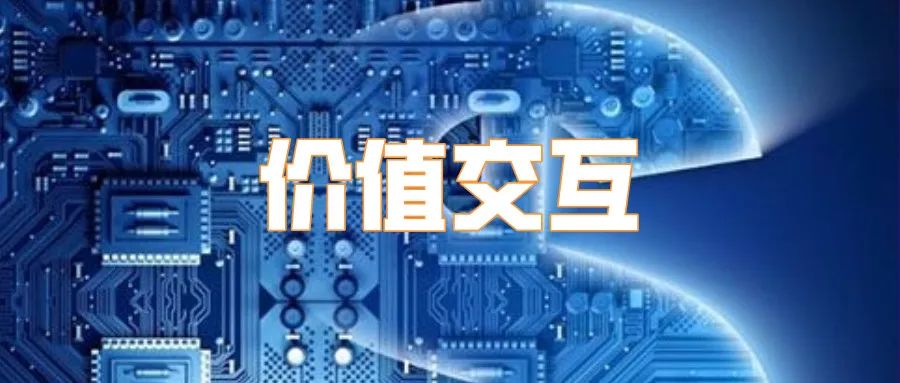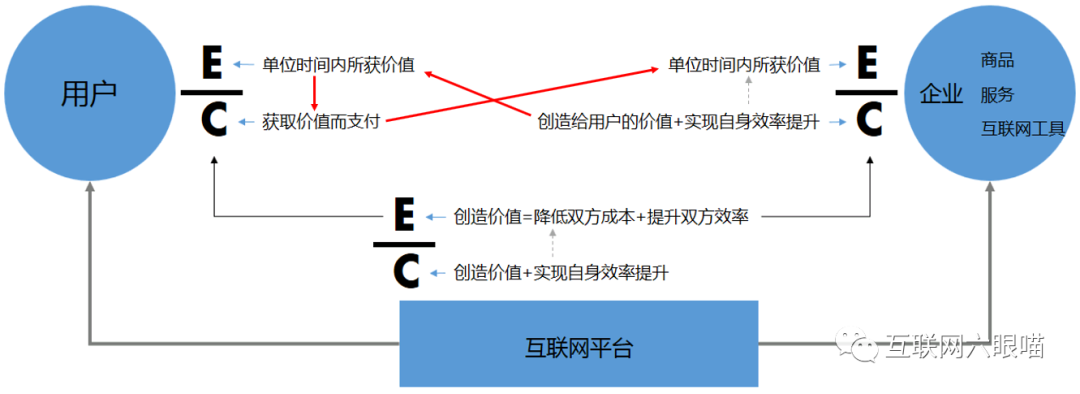What is the logic of building a product architecture? Why is there the concept of “only break fast” in the Internet? It all starts with the business model of the Internet.
Editor’s note: This article comes from WeChat public account “Internet Six Eyes Meow” (ID: AI_PM_Advanced) author: flight feathers meow. Original title “Motive Force for Promoting the Development of Internet Business Model”
Key points
-
The Internet business model is determined by value and cost, and is driven by value.
-
The essence of Internet products is a value transmitter, and the business model of the Internet is to realize this value.
-
The business model is composed of three main aspects: business model (monetization method), product architecture (bearing), and product rules (implementation). It provides value to product users, and the E / C ultimately determines the execution result.
Summary of past love
Internet products are divided into two stages, the essence of which is to provide value to users, thereby reducing user costs and improving efficiency. When the provided core value is provided by the developer, that is, a tool product or a media / content product; when the provided core value is provided by others, the Internet product enters the platform product to provide connection value, and the more connected objects, The greater the value. Therefore, the most important core of Internet products is the product architecture, which reflects how to provide value to users.
What is the logic of building product architecture? Why is there the concept of “only break fast” in the Internet? It all starts with the business model of the Internet.
In this article, let ’s talk about the Internet business model.
WeChat case
I did n’t want to write this case, but I could n’t stand the strict requirements of our magic editor, so I could only take a case and briefly analyze it as a guide.
It should be noted that I have not seen the product architecture of the product analyzed in the case. All analysis of the product architecture is based on the presentation of the product front end.
This case is still an analysis of WeChat. In the previous article, we probably talked about WeChat as a platform. When we connected the parties, we reached a conclusion: if there is no breakthrough iteration in product architecture and product rules, there is no product that can be socialized. Replace WeChat.
This time we are talking about the business model, so we try to use our own experience to analyze WeChat ’s business model and product architecture.
We can see the clues by analyzing the large version of WeChat in the past. In order to be more clear and clear, we are trying to analyze with WeChat IOS versions (to be honest, there are too many variants of the Android version, which is dazzling). See how WeChat uses product architecture to drive the realization of business models and business logic. Therefore, in the analysis, the function iteration related to the product architecture is mainly selected as the analysis, and the lower-level functions are not expanded.
Version 1.0: There are only four functions “Set avatar and WeChat name, send information, send pictures, import address book”, it can be seen that the main purpose of this version is to establish connections and generate connections between users. Only includes relationship chain management (manage yourself, import address book) and communication management (send pictures), this version of WeChat is just a communication tool. Subsequently, the iteration of various small versions still added functions on these two basic modules in the architecture, including “QQ address book, mobile phone address book import”, “address book search”, “” “Blacklist, note friends”, etc., “multi-person call, conversation search” on “communication management”.
Version 2.0: The product structure has not been adjusted, and it is still iterating on “relationship chain management” and “communication management”. But why is it a new big version? The biggest change in this version is from acquaintance connection to stranger connection. “View people nearby” is the biggest change. But the purpose of this change is still to lay a solid foundation for “relationship chain management”. There are also exchanges that include video in “Communication Management”. The other newly-launched functions are all secondary functions. The purpose is to enhance user experience, improve user efficiency, and reduce user costs. I will not repeat them here.
Version 3.0: In this version, the product architecture has been changed. Based on the original “Relationship Chain Management” and “Communication Management”, a “Content Management” module has been added to start connecting content and content creators. The “Content Management” module includes “Getting through Tencent News and Tencent Weibo”, the most important of which is the launch of “Service Number” and “QR Code”. Starting from this version, WeChat started not only as a user relationship chain, but also based on the user relationship chain, expanding to content and offline connections with people. WeChat gradually worksWith the transformation to the platform, business models began to appear.
Version 4.0: Many people say that WeChat started from this version and became a social platform. The biggest change in this version is the launch of “Friends Circle”. But in my opinion, the circle of friends is only an extension of the relationship chain management, and the relationship chain management is still the core. Instead, “open interface, support sharing music, news and other content from third-party applications to friends” and the public account launched in version 4.5 are the key points. With this opening, WeChat’s architecture has begun to extend to content creators, making it possible for business models to be established, thus truly starting to connect to other groups in addition to connecting users. The bottom layer of the product architecture became “relationship chain management” + “communication management” + “content management”, and began to connect more groups. From this perspective, WeChat did open the way to the platform from this version.
Version 5.0: WeChat is out of control on the platform. In this version, the product architecture has changed again: “relationship chain management” + “communication management” + “content management” + “offline management” (new) + “finance” (new). The optimization direction includes: the public account is divided into a subscription number and a service number (providing value for content creators and enterprises), adding small games (preparing for small programs); new directions include: sweeping (will connect various Business groups, especially offline business groups), finance (WeChat payment goes online). Under such a structure, combined with the ability of Guangdiantong, the advertising model and the game payment model began to appear gradually, and the payment ability opened the Jiugongge service model.
Version 6.0: In this version, the biggest change in product architecture is the addition of “mini-programs”, the connection is increased, and the connected groups include the enterprise entrance, which is no longer just the brand owner in the advertising mode. It is a real enterprise communication platform. I believe that the backend of the small program is also connected to the small and medium-sized enterprises and studios that provide services of large and small programs, and eventually formed two major ecosystems, one for the ecosystem of enterprise services and the other for the content services. With ecology and payment in hand, WeChat even has a diversion model.
Version 7.0: Upgraded from 6.0 to 7.0, WeChat has been used for more than 4 years, but this upgrade has not changed much in product architecture. The biggest change is the management of information, upgrading from graphics to video. Although the architecture has not changed, the change in the form of information will eventually drive changes in the product architecture. Looking forward to what the next product architecture will evolve into.
It can be seen that the product structure of WeChat is getting bigger and bigger and it is getting harder to control.
The first four versions are mainly tool-based products. The business model is to build connections between users, but there is no business model, and the business model is missing. According to D = E / C, users are pursuing an uncapped E in their communication, and trying to lower C as much as possible, and when there is basically no difference from competing products on the market, there is basically no chance of making money, even backward payment Possibly, a business model cannot be born.
After the fifth version, there are more connected groups, each group has different requirements for E, and the psychological bottom line for C is also different. At this time, the business model in the business model began to take shape, and the advertising model and the split model appeared.
So, what is the business model?
I. Internet business model
The so-called business model, put it bluntly, is what kind of business logic is used to make money. But no matter what kind of business logic is fundamentally the exchange of value, the business model is to allow this value exchange to proceed smoothly. Therefore, the business model solves the following problems in order:
Who provides value? → What value does it provide? → How to provide value? → How to maximize your value?
“Who provides value?” refers to the market, which can target one group or multiple groups.
“What value do you provide?” refers to physical products or services. The core is to improve the efficiency of the target group and reduce the cost of the target group. For one group, the value provided is explicit and the technology is easy to perceive; for multiple groups, the value provided is “connected” to assist the value generated by one group and quickly pass it on to another group, which requires solid background technology.
“How to provide value?” refers to the value carrier, with the product as the core, and the product sets rules for providing value and makes the rules explicit.
“How to maximize the value?” refers to maximizing the value of the target group while maximizing its own value. The business model should be manifested as a business model, and the business model should be driven by operations. It was not until here that I touched to make money.
In the entire chain, the product becomes the carrier. The product touches the target group to be connected, demonstrates and optimizes the value provided, and at the same time carries the driving of the business model of the operation, so that it can generate revenue. Therefore, if the business model can be realized, it needs to be developed through products.
That is, through the product, let your income be based on the value provided to others.
Second, Internet business model generation
The Internet business model is inseparable from the matching of value acquisition efficiency and cost, whether it is a first-stage type product or a second-stage type product.
For the relationship between efficiency, efficiency and value, cost and product division, see the historical article at the end of the article. For better understanding, the “value” in this article refers specifically to the value acquired in the same time periodValue, not to mention the word “efficiency”, also excludes the situation where product users pay for time. Of course, users can pay for time and apply the following analysis.
Build the foundation of the business model: Object and Value
To build a business model, first of all, it is necessary to know clearly “who provides value?”, that is, to determine the target users.
Target users include core users and extension users. Here, it is necessary to divide the core users and the extension users. Such a division is determined by the users’ importance of the value obtained and the acquisition cost.
The first type is core users. This type of population is also the source of seed users when new products are launched. They believe that the value obtained is extremely important and the cost of acquisition is acceptable;
The second type of users are extension users, who believe that the acquired value is more important and the acquisition cost can be afforded;
The third type of users are potential users, who believe that the value acquired is important, but will not use the product for the time being in consideration of cost. To acquire this part of the users, they can only increase the importance of value in their minds through operations, or reduce their acquisition costs through technological iteration.
Second, make sure what value is provided to the target group. For users, this value is determined by the needs of the target group and the affordable costs.
We will open a new article to discuss in detail the method of mining user needs
For companies or products, this value is determined by the upper limit of the services provided. When the value provided by the enterprise or product meets the needs of the group and the cost is acceptable, then the basis for the formation of the business model appears.
The product architecture is more low-level and needs to be more integrated, rather than simple accumulation. Too much accumulation can only make the product architecture more bloated.
However, the solutions to these problems are different. At this time, product rules need to be introduced to determine. When users are familiar with this set of architecture, based on product rules for value production and value acquisition, the market position of the product is established.
This is why there is a saying that “just break fast”. For Internet products, the essence of “fast” means that when the core architecture is determined, the rules are determined as soon as possible in the market to obtain users.
“From where” is the source of value. When building a product, it is important to clearly define what type of product to build. Different types of products acquire value in different ways, which ultimately leads to deviations in product architecture. For example, do developers provide value, or do other groups of society provide value.
“By what means” is the way of value production. For example, if you build a tool-based product, such as a mailbox, then value production is realized by the developer; if you build a platform-based product, such as Weibo, the product architecture must provide functions to the value provider to enhance the user ’s value creation efficiency Reduce their production costs.
“What kind of value is obtained” is the screening of value after the production of value, through the product rules generated by the product architecture. In this link, there is value expansibility, and the expanded value will eventually achieve cross-border. Such as Didi from taxi to special car to carpool to bicycle.
About cross-border, we will also use an article to explain in detail.
“Who is ultimately provided to” refers to having value, find the group that needs these values, and know how to reach the end user through the product.
The products developed based on the architecture have the ability to provide value, and based on the product architecture, there is another very important element, namely the product rules. Through product rules, it is possible to clarify the method, scope, efficiency and cost of value transfer.
Product architecture + product rules bear the business model and realize the business model. The product architecture determines the upper limit of the business model, such as the value provided by the tool product and the number of groups connected to the platform product; the product rules as regulators determine the expansion of the business model. Mutual support system.
For example, for long video products, video producers, brand owners, and users are connected. At the beginning, the product rules were free for users, and a backward payment business model was formed. The differentiated generation of video content provided users with more value. The product rules changed accordingly, and gradually evolved into forward payment + backward payment Business model.
A small question: How should I explain the P in the VIP that appeared in the video product collection some time ago?
Video products give users differentiated content and satisfy the user’s value, but this value acquisition is also efficient. Want to get higher efficiency? Learn about the advanced on-demand benefits? Ensure that the cost you pay is sufficient to meet your pursuit of efficiency!
So why does the product architecture determine the upper limit of the business model?
The product architecture determines the connected groups or the value provided, and this is precisely the limit of the scalability of the business model. For example, the architecture of video products determines that content creators and content consumers are connected. It is extremely difficult to extend the business model of video products to the field of life services.
So what drives the growth of the business model under the product architecture?
It is the value acquired by the connected group, and the efficiency of acquiring value, which determines the growth of the business model, such as the case of WeChat we analyzed earlier. Whoever wants to get greater value, who wants to achieve higher efficiency, can pay for it at an affordable cost.
So, we saw the backward payment model of video products. The value that brand owners want to get is product sales. To obtain such value, you need to pay the cost. However, the CPM model obviously does not greatly improve the efficiency of commodity sales. At this time, CPC and CPA gradually became the mainstream.
This is why most Internet companies are talking about users when they are publicizing or issuing data reports, not mentioning other user groups. This is not to say that Internet companies only serve users, but that publicity is easier for advertisers to know. Such a report is also providing value to advertisers in a sense.
At the time of the forward payment model, it began to satisfy content consumers ’pursuit of content value and content acquisition efficiency.
When referring to various charging models, namely business models, then we have to mention the relationship between product rules and business models. The relationship is very simple, that is, the two sides support each other. In general, the purpose of product rules is to regulate the behavior of users, so that the business model becomes a reality. For example, if a video website determines a business model of backward payment, then the product rules must match this model. On the other hand, product rules also affect the business model. For example, the social rules in social products determine whether the business model is feasible. The online process of advertising in the WeChat circle of friends illustrates this point well.
Another small question: how to balance forward payment andWhat about backward payment?
It is estimated that this question is always being considered by all the friends who make content products. The essence of the problem is that “fish and bear paws can’t have both”. Users pay and don’t want to see ads. If they add ads again, the user’s psychological cost will increase. The problem is that, regardless of CPC and CPM, they are changing, but the membership payment is fixed. Although the membership payment is stable, it may not catch up with the premium of advertising, but advertising also has risks. On the premise that there is no breakthrough in advertising resources, if you want to balance, you can only start with D = E / C and standardize or price the value and cost of each group to calculate an optimal balance point. Or, there is a breakthrough in advertising resources, but it does not affect the cost of members’ access to videos.
From this, we can draw a small conclusion: the Internet’s business model creates value at its own cost (the enterprise itself also needs to follow the E / C model), thereby forming a business model to help the user group reduce the cost of use To improve efficiency. When both the value provided and the cost paid are priced, and the relationship between the two is fixed, a business model is formed.
Three, the evolution of the future Internet business model
How will the future Internet business model evolve? We can see that the Internet’s empowerment of social development will be more comprehensive. All places in the society where value flows are not smooth, the Internet will enter, and technology will be used to promote the faster flow of value and create new value in the process of value flow , So as to generate new business models, so as to achieve more diverse ways of monetization.
In this process, it can be a tool or a platform. As a tool, it will be more detailed and vertical, and technology will be more explicit; as a platform, it will be more low-level, the role of connection will be greater, and the value generated will be greater.
As the social division of labor becomes more and more detailed, according to D = E / C, everyone will put forward new requirements for efficiency and cost, requiring that the efficiency be improved as high as possible and the cost be reduced as much as possible. And these new requirements are the future development space of the business model.
Four, conclusion
The business model consists of three main aspects: the business model (the way to make money), the product architecture (bearing), and the product rules (implementation). It provides value to product users, and the result is ultimately determined by E / C.
Therefore, the essence of Internet products is a value transmitter, and the business model of the Internet is to realize this value. Thus, the business model is based on the business modelThe formula is a specific form of expression, and the product architecture determines the upper limit of the business model. The business model is implemented through product rules, which act as regulators and determine the expansion of the business model.
Feiyu Meow, 7 years of market research and user research, hone the logic and ideas in analysis, flexibility and accuracy in application; 10 years of Internet The immersion of the water, instilling in-depth knowledge and understanding of the industry, judgment and insight into the trend. Information gathering and thinking have become routine, and induction and interpretation have become habits.






